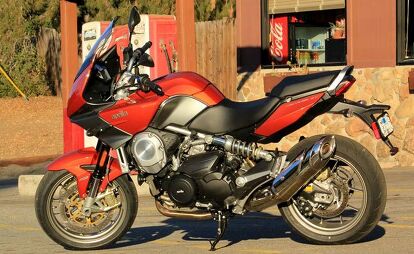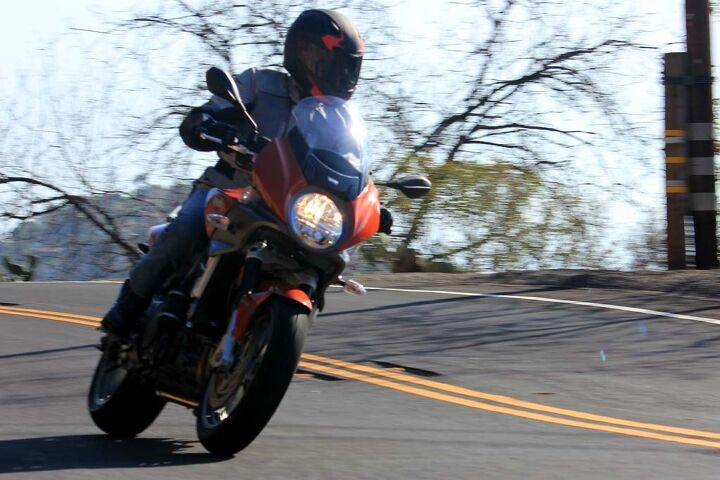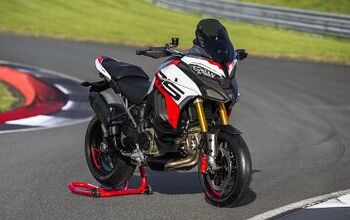2014 Aprilia Mana 850 GT ABS Review
Sportbike? Maxi-scooter? Whatever. The Mana's more proof that Piaggio is Italy's best-kept secret.
Well, I didn’t really expect the Aprilia Mana 850 GT to be much of a sportbike, but it is. Amazingly enough, when we set off into the sunset back down Ortega Highway toward civilization after a nice day riding, we didn’t get stuck behind a single cement mixer or weaving pickup or any vehicles at all – completely unprecedented – which meant we could set our own pace through all those fast, smooth sweepers. The Mana settled into a surprisingly swift one.
2014 Aprilia Mana 850 GT ABS
| Engine | 16.5/20 |
| Suspension/Handling | 12/15 |
| Transmission/Clutch | 8/10 |
| Brakes | 8.5/10 |
| Instruments/Controls | 3.5/5 |
| Ergonomics/Comfort | 8.5/10 |
| Appearance/Quality | 8.5/10 |
| Desirability | 8.75/10 |
| Value | 8/10 |
| Overall Score | 82.25/100 |
Horsepower’s not really a requirement on a road like Ortega, and the Mana’s dyno-derived 54 at 8000 rpm felt like enough. It is an Italian V-Twin after all, and it even hangs from a steel trellis frame. Steering’s neither too light nor heavy, and fast enough. Homo erectus ergoes and an aluminum handlebar put you in total control and, yeah, the faster I rolled into the corners, the more the Mana reminded me of a nice freight-train Ducati, before they went all Panigale on us. If you were expecting low-rent scooter tires, you’ll be surprised to find Dunlop Q2s, in full-on 180/55 and 120/70 sportbike sizes on the Mana’s rims. The fork’s not adjustable, but it is a firmly sprung 43mm inverted unit, and the rear end plays right along.
The gearbox is, weirdly enough, the thing that really makes the Mana such a fun sportbike. You can leave it in full auto (Touring, Sport, or Rain) and just motorboat along. The other thing you can do, with the push of your right thumb, on the fly, is put it in Sport Gear, and shift the 7-speed for yourself. The Mana’s got thumb paddles for your left thumb and forefinger. I never cared for them on a motorcycle personally – my hands have enough to do. What the Mana has that the others don’t is a shift lever for your left foot, as Allah intended, allowing toes to shift virtual gears if you’re not keen on paddles.
It’s a continuously variable ’box like scooters have used since the ancient Greeks, but controlled by the miracle of modern electronics instead of spinning weights and springs. Scare yourself with what feels like too much speed into a corner, and all you need to do is tap down on the shifter, no clutch required. Engine braking increases one-seventh, and the fact that it’s a belt means there’s no lurch at all – you just slow down a bit, smoother and more controllably than by dragging a little rear brake. Downshift leaned way over if you want, no drama. Upshifting at corner exits is just as smooth, instantaneous and lash-free.
There’s no tachometer, but in Sport Gear mode, three sequential yellow lights followed by a red across the top of the dash tell you when to shift. Very racy, easy to see, and quite Ducati-ish sounding. The CVT belt is super-efficient, but it’s incapable of transmitting any harsh to your buzz. It’s not going to be the hot set-up for drag racing; you can’t really blast off from a start. But the CVT makes the Mana sneakier fast than it seems; lots of expensive Orange County automobiles grow quickly small in the Mana’s mirrors when the light goes green, without really trying.
For curvy-road use, I was surprised how capable the sensible commuter-appearing Mana turned out to be, the classic MTV video librarian in the cat glasses and tight bun who transforms into the opposite of the girl next door. Some might find the Honda NT700V more appealing as an overall package. Each to his own, I suppose. I find the Italian bike far, ahhh, sexier and more fun to ride.
2010 Honda NT700V vs. Aprilia Mana 850 GT ABS
Speaking of which, though the siren song of the maxi-scooter becomes harder and harder to resist as one grows old and gray, the nearly equally convenient Mana’s a life-affirming motorcycle that tells the world you’re still capable of straddling a thing, not a rolling admission that you’ve given up all hope and have stored your manhood in the underseat compartment next to the Depends and oatmeal. I kid, but only a little.
The Mana shows you can still get your right leg up, at least. The seat’s not exactly low, at just over 32 inches, and it’s more firm than plush. Which turns out to be less a problem since my butt is lately more plush than firm. It all works out, doesn’t it? You can dial back the preload out back with the handy knob, and adjust rebound damping with a penny. This bike is user friendly. The airflow over the windscreen can be turbulent; you can cut it down or swap it out easily enough. On chilly days, it’s way better than nothing, and the shape of the gas tank pushes air around your thighs, too. There is a little vibration above 85 or so, more through the footpegs than the bars, noticeable but to me not at all objectionable.
It’s no Burgman trunk, but the Mana’s helmet-shaped (ie. rounded on the bottom) storage compartment is designed to be able to hold a helmet. I couldn’t get any of my sized-large full-face helmets to fit, but lids from other staffers were able to be squeezed in, and open-face ones fit easily inside the 15-liter (approx.) cavern. Sadly, there are no external helmet locks. You can fit a couple bottles of wine, a quart of milk and a pound of Trader Joe’s Dark Roast, no problem. Remove the plush liner and there’s a drain plug in the bottom, in case you need to transport iced-down beverages or fresh-caught salmon maybe. There’s also a 12V outlet and a light, and even a little hydraulic strut to hold the lid open.
A little bit of storage on a motorcycle goes a long way, and beats schlepping a backpack wherever you go, though unfortunately my 13-inch laptop won’t quite fit either. Meanwhile, the fuel tank’s tucked away at the rear, doing its job holding 4.2 gallons and keeping the cg low, and passing gas to the single 38mm Marelli fuel injector body at the rate of about 46-48 mpg. Fully fueled, the Mana weighs about 530 pounds.
Yup, $11,199 is not cheap, but not only is the Mana a unique motorscooter (literally), it’s also very well turned out with braided steel brake lines, two-channel ABS for those of us who don’t like linked brakes, Brembo brake calipers, cool wheels, really nice suspension and a general level of thoughtful put-togetherness that makes the Honda NC700X copy feel a bit cheap. Which it is compared to the Mana: The dual-clutch automatic Honda with ABS retails for $8799.
The Mana does almost everything better than the Honda, including make you feel sort of cool to be seen with it, and if the Honda’s DCT is a bit more technologically advanced, the Mana’s old-school CVT and its Sport Shift are surprisingly competent. According to the maintenance schedule, the Mana requires service every 12,000 miles or so. How hard could it be? There are four valves per cylinder also, and one cam, with screw-and-locknut adjusters.
Aprilia’s been producing the standard Mana 850 since 2008, and created the GT version in 2010 by adding the fairing and antilock brakes. Seems like they may have improved its suspension, too, since we didn’t experience any of the wallow or sidestand grinding Pete complained about on the naked Mana in 2009. Our bike consistently returned at least 46 mpg, too, as opposed to the 40 Pete got.
I’m not sure how I’ve only just now gotten to ride the Mana, but I’m glad I did. The Piaggio Group continues to make some of our very favorite motorcycles. Add this one to the list alongside the RSV4, the Tuono, the Moto Guzzi Griso, the V7 Racer, the California 1400, the MP3 … along with them, the Mana feels like one of the best-kept secrets in motorcycling. Scootering. Both.
Related Reading
2010 Honda NT700V vs. Aprilia Mana 850 GT ABS
2014 Honda NC700X DCT ABS Review
2013 Uber Scooter Shootout + Video
2014 BMW C600 Sport Review
2013 Honda CB500X Review
2013 Beginner Sportbike Shootout Part 2 + Video
2013 Moto Guzzi V7 Racer vs. 2013 Triumph Thruxton + Video
2012 Adventure-Touring Shootout + Video
All Things Moto Guzzi on Motorcycle.com
More by John Burns



























![Aprilia Mana 850GT Introduction [video]](https://cdn-fastly.motorcycle.com/media/2023/05/07/11552470/aprilia-mana-850gt-introduction-video.jpg?size=350x220)















Comments
Join the conversation
Since so few reviewers seem to speak about vibration (why when they sure mention when an engine is smooth) it must mean that the Aprilia Mana GT vibrates like some gorilla beating on a tin can with a hammer.
"There is a little vibration above 85 or so, more through the footpegs than the bars, noticeable but to me not at all objectionable." is a line liner yet on and on about the keys and what they operate.
WHAT ABOUT BELOW 85?
Why can't reviewers make this a standard inclusion when speaking about a bike, especially the longer rides portion? It seems to me and probably a lot of others that if a bike vibrates much, long rides become a royal PITA and dance around the issue all you want (amplitude, frequency and all that) who really likes to ride a motorcycle if it vibrates a lot? Maybe around town it isn't a big deal but put some miles on and vibration quickly becomes a focal point on the pleasure meter. Thick gloves and swapping grips is rarely an answer.
I did read one reviewer who put in some tack on comment that the Mana's engine will vibrate quite a lot when pushed just a bit. Sorry but that becomes a deal killer and given the number of Mana's that seem to come up for sale soon after they are bought might be some indicator that it's just darn unpleasant to ride other than on very short trips.
It isn't 1980 or before when Honda 350 twins rattled your fillings and it was ok, vibration management is something Aprilia Manages to do on their Pegaso Cube and it is a single cylinder thumper, yet capable of going quite long distances without blurring your vision.
The Mana might not be a real hard vibe machine but clearly, when a reviewer doesn't want to talk about a very fundamental aspect of how a bike feels on more than a 7-11 run, something is up. Maybe mentioning the vibes doesn't mesh with marketing?
More real reviewing, less fluff and copy paste from brochures please.
I got a Mana 3 months ago. Blown away how much better it is than my Ninja 650. I love the foot shifter, but usually don't use it. He's right, it's WAY faster than any car and most motos. And as someone who enjoys drive through occasionally, the extra compartment is perfect for that! I also put an aftermarket pipe on there and it's LAF! Everyone can hear me coming, which is just way safer for me. I will have a hard time ever selling this bike. Only problem is, it takes a couple minutes to warm up, and the windshield is too small. I'll be buying a touring screen soon enough.